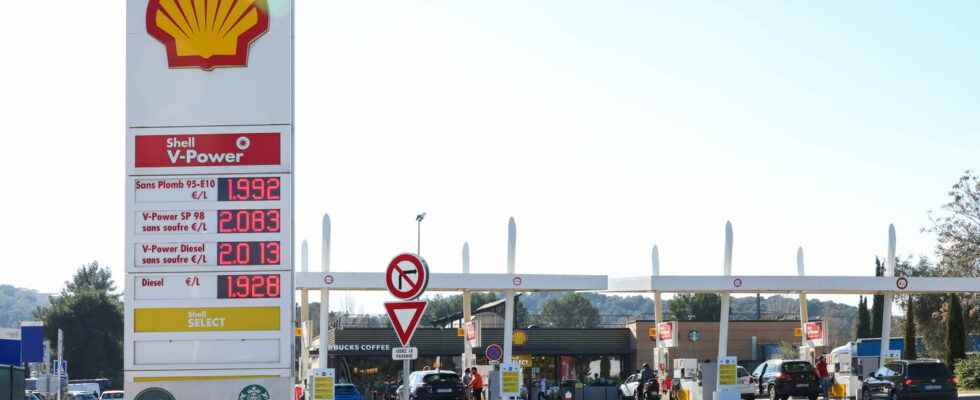PRICE OF PETROL. Finally a lull at the pump for motorists? After a spectacular surge, fuel prices at the gas station are expected to fall in the coming days. Is it already visible? We take stock.
[Mis à jour le 15 mars 2022 à 09h39] After soaring fuel prices, which reached peaks in a few days, crossing the 2 euro per liter mark in many service stations, will the next few days be synonymous with a welcome calm? Experts have been scrutinizing the price curves for several days, seeing in the price of a barrel of oil, the famous brent, a reason for optimism. After peaking at $139, the price has fallen in recent days, approaching the $100 mark on March 14.
As a result, if the pass-through time between oil price trends and the price at the pump is estimated at 10 days, prices should therefore fall significantly in the coming days. For the moment, it is difficult to see an improvement since the national average did not change much on Tuesday March 15 in the morning with average prices at 1.987 euro/litre for unleaded 95 E10 and 2.061/litre for diesel. It will therefore be necessary to be patient and if possible to postpone your visit to the service station by a few days.
Faced with this crisis situation, the government has promised new aid, in the form of a discount of 15 cents on a liter of petrol. What reduce the bill of 7.50 euros for a full tank of 50 liters, an average tank for a vehicle in France. “For every 60 liters you will save 9 euros“, also summed up Prime Minister Jean Castex. This measure will soon come into force. Here is what to remember from this announcement as well as the list of gas stations the cheapest in France to help you find the most affordable pump near you.
In addition to moderating your travels, practicing carpooling if you can, the best thing is still to compare the prices charged in the service stations around your home. Tedious? Not that much since many sites offer this service on the internet. You can also base yourself on the official government website, fuel.gouv.fr which proposes to find the prices that must be indicated to the State by the managers of service stations. Linternaute.com has prepared a file showing you the prices department by department.
Our partner Essence&Co also offers this service via collaborative data provided by Internet users. You can find the search engine below. It is possible to compare fuel prices at service stations near you. Available on Android or iPhone, it offers daily fuel prices based on user feedback to indicate current prices.
The government websiteprice.fuel.gouv.fr” also offers you price statements by department and type of fuel (be careful to clearly differentiate unleaded 95, 98 or E10). The price statements are updated on a weekly basis. What will help you find the cheapest gas stations through an interactive map listing the gas stations near you.
As you have noticed, there are sometimes sometimes substantial price differences depending on the service station: between distributor brands (supermarkets in particular) and oil group stations, the difference can sometimes seem significant. It is explained by various parameters including the brand image but also the famous additives. You may know them by their trade name. Excellium fuel, for example in the Total network, contains many additives. Incorporated into the fuel, they are used to improve its quality and therefore its performance. Also intended to protect the engine or the tank, they also act on higher prices, which sometimes gives rise to controversy over their usefulness. Marketing argument used to justify these prices or real benefit for the car, the debate is lively.
What is the share of taxes in the price of gasoline at the pump? According to Total, taxes represent “the most important part of the price of fuel”. In 2018, according to the company, the taxes collected by the State represented for example “63% of the price of Unleaded 95-E10 and 60% of that of diesel”. Gasoline tax is in fact divided into two different taxes: VAT, and the domestic consumption tax on energy products (TICPE). There is also the general tax on polluting activities (TGAP). The TICPE is also higher on gasoline than on diesel. Depending on gasoline prices, the TICPE represents nearly 70 cents on gasoline, 60 cents on the price of a liter of diesel.
The carbon tax is a tax on CO2 emissions. It was implemented in 2014. It was to increase on January 1, 2019 and add 3 cents more to the price of a liter of diesel and 6 cents to the price of a liter of lead-free. Nothing happened: the government decided to cancel its increase when it could have brought 3.9 billion euros in additional revenue to the State. This decision follows the discontent of the yellow vests at the end of 2018. Note that the carbon tax, a component of the TICPE, finances only “very little” the ecological transition.
According to a Senate report on revenue for 2016, “out of the 4 billion euros of additional revenue expected from the carbon component in 2016, 3 billion euros are returned to companies under the tax credit for Competitiveness and Employment (CICE), and 1 billion euros for households, through reduced VAT rates applicable to energy renovation work on housing and in favor of social housing and intermediate housing”. For the Senate, the increase in the carbon tax therefore results from a “logic of budgetary return” and is not particularly used to finance the ecological transition.
